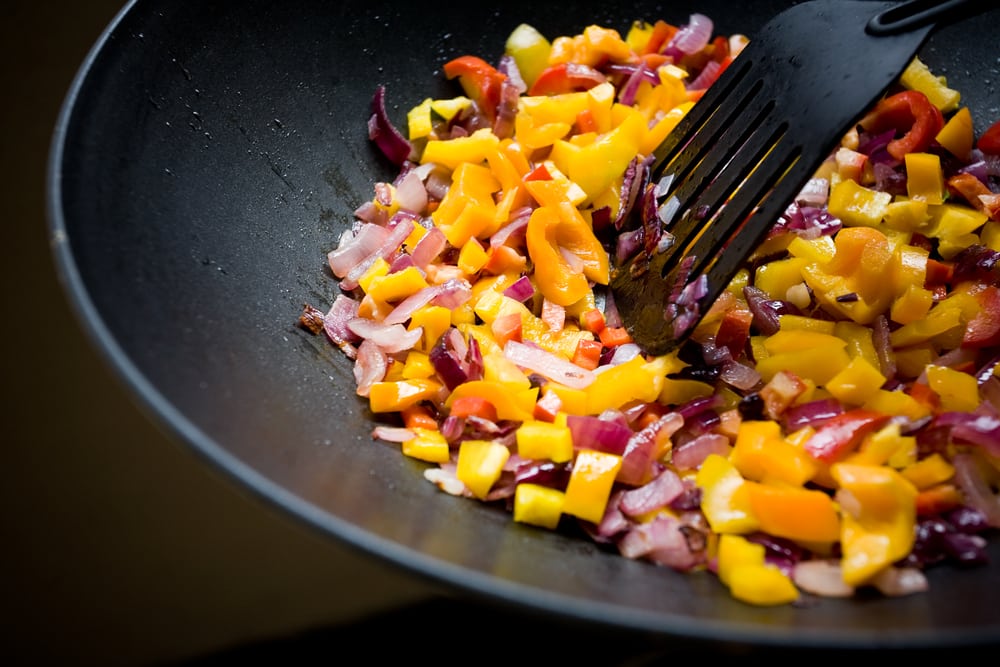
When it’s time to purchase a new pan, we are sure you will have a hard time making the final choice since there are so many types available in the market. However, saute pan vs. wok is a common point of comparison, and we are sharing everything you need to know about these two different pans!
Saute Pan vs Wok: Functionality Comparison
Saute Pan
The saute pans can be easily identified by their unique size and shape. To illustrate, it has higher yet straight sides, making it suitable for cooking larger quantities of food. A saute pan is likely to be bigger than our conventional skillets and frying pans. In addition, the saute pans are paired with a handle and lid, but that’s not all that you need to know about them. When compared with woks, the saute pans are smaller as compared to woks which means they will consume less space on the stovetops.
Still, these pans are big enough to cook a sufficient amount of food without overstuffing the pan. These pans are shallower, which makes them easy to store (do you know they can be simply slid into the drawer?). In addition to this, the saute pans are extremely versatile and can perform different functions, such as frying different food items and meat. The best thing about a saute pan is that you can leave the food still rather than mixing and tossing constantly.
This means that you can cook a few fish fillets and steaks at once, how amazing! This is basically because the saute pans are designed with a leveled and flat bottom while the surface area is quite wide. Having that said, it does wonder in simmering the curries and sauces. Moreover, it can be used for making stir-fries, but you need to gain the right balance of movement and heat to ensure the veggies don’t become soggy. On the other hand, keep in mind that it can overspill.
It’s important to understand that if you are a beginner at cooking, you might struggle using the saute pan because it’s difficult to toss in the saute pan. This is primarily because the saute pans are heavier, and the straight side makes it challenging to toss. That being said, if you are a beginner, it’s suggested to start with lesser food, so you don’t end up with a mess.
Wok
To begin with, woks are a piece of art, and they are amazing pans to cook with. They are characterized by their outward and wide sloping sides, which means the food won’t spill. In addition, they are designed with a tapered shape which means the primary surface area of the pan will be smaller. For the most part, the woks are used in Asian and Chinese cuisine. As far as the construction is concerned, wok is made from carbon steel, but some also have cast iron and nonstick build.
When it comes down to the benefits of wok, they are perfect for ensuring the food keeps moving. This is because the wok has high and slanted sides, making it easier to move around the food. In addition, it allows a dipping motion, and you can even flip the food. The wok can be held with the handle, and it can be tilted during stirring. The best thing about wok is that it allows food tossing without causing any spillage and should be used for foods that need to be cooked at higher heat.
Given the wide sides and much deeper capacity, it ensures that you can stir and toss the food vigorously. Moreover, the woks are designed to tolerate higher temperatures, making them suitable for flash-cooking veggies and meat. Having that said, it can be used for making noodles, rice recipes, and stir-fries. With wok, you will need to make sure that food is properly moved, so the food doesn’t burn, the meat gets charred, and veggies remain crunchy.
Wok is a great pan for people who want access to different cooking rates because it’s shaped to have cooler sides and hotter bottom. That being said, you can cook different food items at different times and temperatures. To illustrate, you can add meat to the hottest part of your wok and add the veggies later as they need lesser cooking time. Even more, it’s perfect for you to cook with less oil, and even if you add more oil, it will be properly drained away.